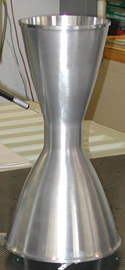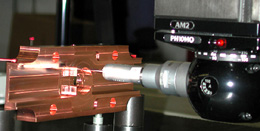 |
|
Measuring up - micron by micron by Mike Perricone
Whether components are one-of-a-kind or just one of a million,Quality Control uses precision coordinate measuring instruments to show whether they meet the standards that make them fit for use.Software called PC-DMIS is Windows- based,and integrates with CAD (computer-assisted-drawing)files to direct a touch probe to survey an array of points in three dimensions. The central component of the NuMI horn (left)was machined from a solid block of aluminum,with an intricate conical shape and extremely thin walls that must transmit large and rapid radiofrequency pulses.Thus,uniformity is the critical property —but the walls were thin enough to generate concern about being damaged by the touch probe tool pressure itself.Rob Riley surveyed the component through a range of cross-sections,inside and out,finding they were within permissible tolerances.Quality Control measured horns for both the NuMI and MiniBooNE neutrino experiments. Couplers for the linear collider R & D project (top) conduct radiofrequency pulses to accelerate electrons,and Quality Control has been examining different designs to provide feedback in the evolving design of the component. The data will be used in choosing a design,selecting a vendor who can produce the components,and controlling prices. A linear collider would require about a million couplers.Above,data from the Avant optical measuring machine took the form of graphic output —simultaneously showing the outline of the part as designed,and the deviations from the design specifications in an exaggerated scale to make inaccuracies more obvious.The Avant took data on 4,026 points on this lamination for the high-field VLHC magnet option.In the scale for deviation from the nominal dimensions,each gridline represents a distance of 25 microns —and the width of a human hair is usually 50 to 75 microns. |


